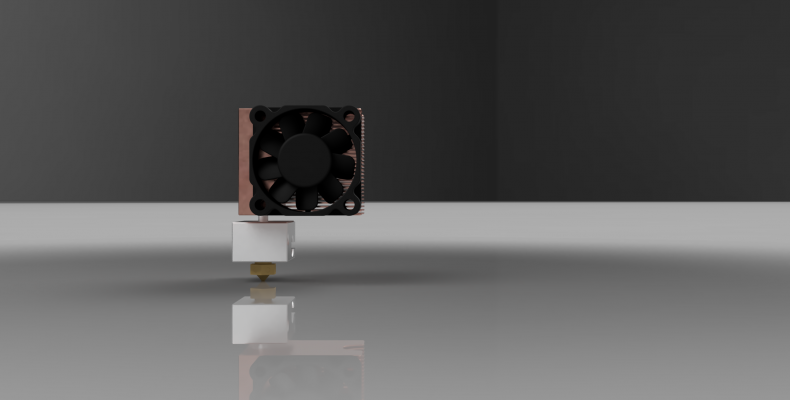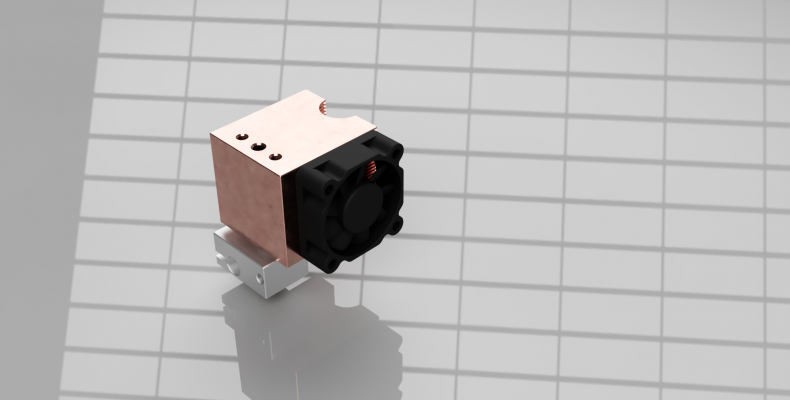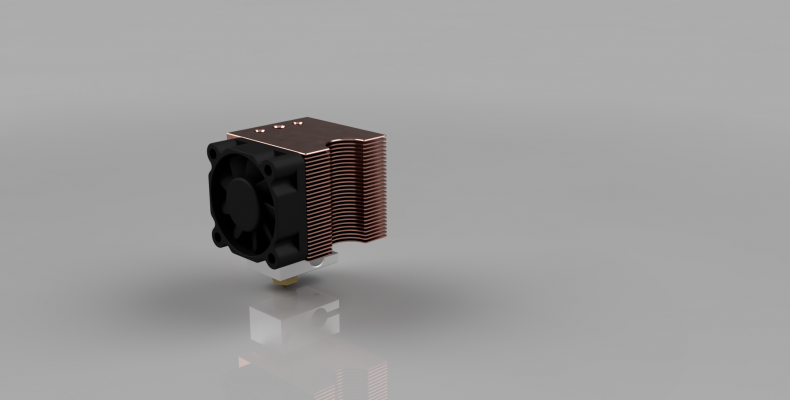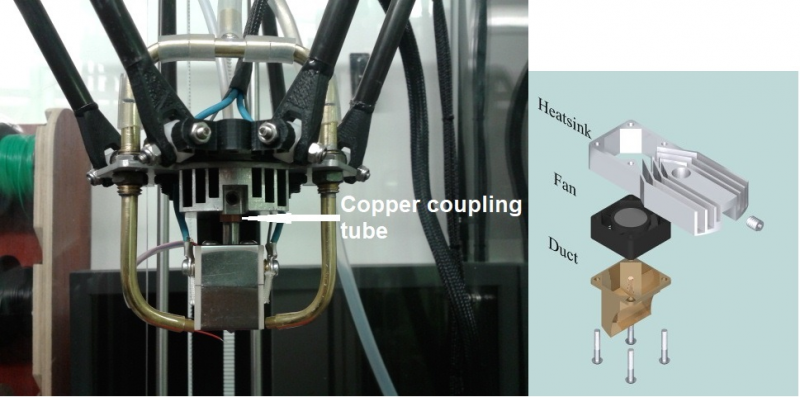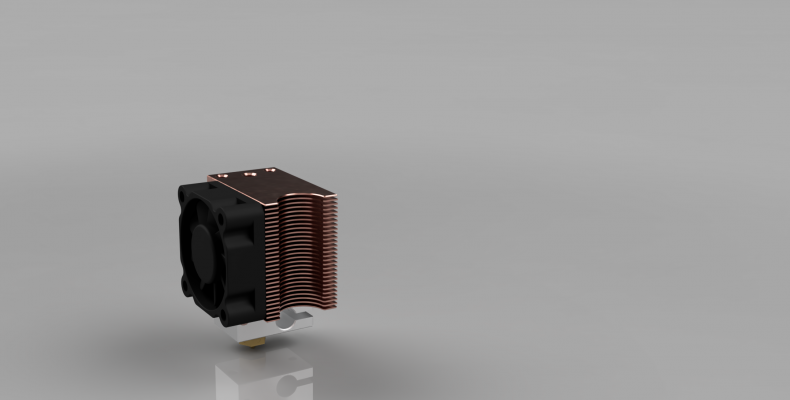Why don't we use better Heat sinks?
Posted by Origamib
|
Why don't we use better Heat sinks? May 31, 2020 07:58AM |
Registered: 8 years ago Posts: 601 |
So this idea came to me whilst I was designing my latest printer. Designing the hot end gantry is normally quite the pain. you're trying to squeeze a lot of components in a small space, not helped by the geometry of the hot end which is usually circular and utilising outdated mounting systems like the groove mount.
So why are nearly all hot ends designed with circular heat sinks with relatively thick fins that don't maximise surface area? why don't we design them more like a CPU heat sink? I'm legitimately interested in an answer to this, because I have a concept for using a skived copper heat sink. Theoretically cheaper to make (although I haven't searched for quotes on this) as the process of making skived heat sinks is to use a blade to peel fins off a block of copper or aluminium. You could make large batches in one go and very quickly, surely this is cheaper then making round ones on a CNC lathe (I'm assuming this is how E3D produces them)?
Here is my concept using skived fins that are 0.4mm thick and spaced 0.7mm apart. The base of the heat sink is 10mm wide and allows space for mounting fans directly to it. The grooved section is to allow easy wire tidying.
Edited 2 time(s). Last edit at 05/31/2020 08:06AM by Origamib.
So why are nearly all hot ends designed with circular heat sinks with relatively thick fins that don't maximise surface area? why don't we design them more like a CPU heat sink? I'm legitimately interested in an answer to this, because I have a concept for using a skived copper heat sink. Theoretically cheaper to make (although I haven't searched for quotes on this) as the process of making skived heat sinks is to use a blade to peel fins off a block of copper or aluminium. You could make large batches in one go and very quickly, surely this is cheaper then making round ones on a CNC lathe (I'm assuming this is how E3D produces them)?
Here is my concept using skived fins that are 0.4mm thick and spaced 0.7mm apart. The base of the heat sink is 10mm wide and allows space for mounting fans directly to it. The grooved section is to allow easy wire tidying.
Edited 2 time(s). Last edit at 05/31/2020 08:06AM by Origamib.
|
Re: Why don't we use better Heat sinks? May 31, 2020 10:01AM |
Registered: 6 years ago Posts: 1,007 |
And why a separate heatsink ? Why not use it as the base of the extruder on which to mount the hobbedgear plus idelr and motor that will be cooled at the same time ? 
I use half of this: [www.banggood.com]
"A comical prototype doesn't mean a dumb idea is possible" (Thunderf00t)

I use half of this: [www.banggood.com]
"A comical prototype doesn't mean a dumb idea is possible" (Thunderf00t)
|
Re: Why don't we use better Heat sinks? May 31, 2020 10:07AM |
Admin Registered: 13 years ago Posts: 7,002 |
|
Re: Why don't we use better Heat sinks? May 31, 2020 10:14AM |
Registered: 12 years ago Posts: 1,450 |
I know very little about skiving as a machining process so won't comment on that. I will, however, comment on the use of copper in this otherwise very interesting design. I feel I am able to give some input in this as I have prototyped a few heatsinks and hotends with different materials.
While the thermal conductivity of aluminium is only about 60% of the thermal conductivity of copper, the demand on a heatsink is to transmit heat from a source which will likely be less than 100°C to the air at say 20°C. For this purpose, the difference between aluminium and copper is not very significant. By comparison, the density of copper is about 3 times that of aluminium and is very significant if the moving mass of the heatsink is important - as it usually will be.
The machinability of pure copper and aluminium are both poor, particularly in their annealed state, but easily machinable aluminium alloys usually retain more of their thermal conductivity than equivalent copper alloys. Brass, for example, can have as little as 6.5% of the conductivity of copper while 6061 Aluminium alloy has >80% of the thermal conductivity of pure aluminium.
The situation on a hotend heater block is somewhat different as there will be no fragile fins and the increased conductivity of copper at the higher temperatures allows the heater block to be smaller. An additional advantage of using copper for the heater block is that the ca 50% higher specific heat of copper creates a reservoir for sudden demands for heat.
Mike
Tables of conductivities etc..
[www.engineeringtoolbox.com]
[www.engineeringtoolbox.com]
[www.engineeringtoolbox.com]
While the thermal conductivity of aluminium is only about 60% of the thermal conductivity of copper, the demand on a heatsink is to transmit heat from a source which will likely be less than 100°C to the air at say 20°C. For this purpose, the difference between aluminium and copper is not very significant. By comparison, the density of copper is about 3 times that of aluminium and is very significant if the moving mass of the heatsink is important - as it usually will be.
The machinability of pure copper and aluminium are both poor, particularly in their annealed state, but easily machinable aluminium alloys usually retain more of their thermal conductivity than equivalent copper alloys. Brass, for example, can have as little as 6.5% of the conductivity of copper while 6061 Aluminium alloy has >80% of the thermal conductivity of pure aluminium.
The situation on a hotend heater block is somewhat different as there will be no fragile fins and the increased conductivity of copper at the higher temperatures allows the heater block to be smaller. An additional advantage of using copper for the heater block is that the ca 50% higher specific heat of copper creates a reservoir for sudden demands for heat.
Mike
Tables of conductivities etc..
[www.engineeringtoolbox.com]
[www.engineeringtoolbox.com]
[www.engineeringtoolbox.com]
|
Re: Why don't we use better Heat sinks? May 31, 2020 11:05AM |
Registered: 6 years ago Posts: 1,007 |
An other problem of this kind of heatsink is its height. It adds more than 25 mm to the distance from the hobbgear and the nozzle tip. A flat easily available Al heatsink like I use just adds 10mm.
"A comical prototype doesn't mean a dumb idea is possible" (Thunderf00t)
"A comical prototype doesn't mean a dumb idea is possible" (Thunderf00t)
|
Re: Why don't we use better Heat sinks? May 31, 2020 12:41PM |
Registered: 12 years ago Posts: 1,450 |
I also used a flat heatsink as shown below. I did find it an advantage to extend the coupling distance as shown by the bit marked "Copper coupling tube".
This photo is of an earlier model and the length of the copper tube was extended then trimmed to get the best thermal consistency across a range of materials. In later models, the tube was hidden beneath a PEEK terminal block so not available to photograph. The detail inset is to clarify the shape of the heatsink.
Mike
This photo is of an earlier model and the length of the copper tube was extended then trimmed to get the best thermal consistency across a range of materials. In later models, the tube was hidden beneath a PEEK terminal block so not available to photograph. The detail inset is to clarify the shape of the heatsink.
Mike
|
Re: Why don't we use better Heat sinks? May 31, 2020 04:32PM |
Registered: 8 years ago Posts: 601 |
Quote
MKSA
And why a separate heatsink ? Why not use it as the base of the extruder on which to mount the hobbedgear plus idelr and motor that will be cooled at the same time ?
I use half of this: [www.banggood.com]
Quote
MKSA
An other problem of this kind of heatsink is its height. It adds more than 25 mm to the distance from the hobbgear and the nozzle tip. A flat easily available Al heatsink like I use just adds 10mm.
I think this is a legitimate train of thought, and certainly seems to be where E3D is headed. In my design I can't actually fit a standard nema 17 driven extruder but if i could, I would.
As for the height, my design is actually 12mm shorter then the E3D V6, but I do agree that where possible combining the metal elements of a motor or gantry into the heat sink makes perfect sense.
Quote
Dust
Overkill, and if made from copper expensive.
Cost will be the decider. If it works better and costs roughly the same to the alternatives it's not overkill. Skived copper heat sinks cost around £5 from Aliexpress for a 30mm heat sink and E3D charge around £10-15 for a heat sink. Slice engineering charge $40 for a heat sink for their hot end.
Quote
leadinglights
I know very little about skiving as a machining process so won't comment on that. I will, however, comment on the use of copper in this otherwise very interesting design. I feel I am able to give some input in this as I have prototyped a few heatsinks and hotends with different materials.
While the thermal conductivity of aluminium is only about 60% of the thermal conductivity of copper, the demand on a heatsink is to transmit heat from a source which will likely be less than 100°C to the air at say 20°C. For this purpose, the difference between aluminium and copper is not very significant. By comparison, the density of copper is about 3 times that of aluminium and is very significant if the moving mass of the heatsink is important - as it usually will be.
The machinability of pure copper and aluminium are both poor, particularly in their annealed state, but easily machinable aluminium alloys usually retain more of their thermal conductivity than equivalent copper alloys. Brass, for example, can have as little as 6.5% of the conductivity of copper while 6061 Aluminium alloy has >80% of the thermal conductivity of pure aluminium.
The situation on a hotend heater block is somewhat different as there will be no fragile fins and the increased conductivity of copper at the higher temperatures allows the heater block to be smaller. An additional advantage of using copper for the heater block is that the ca 50% higher specific heat of copper creates a reservoir for sudden demands for heat.
Skiving uses a plane blade (like a wood plane) to create a fin and then fold it up in one motion. (check it out on YouTube, its weirdly hypnotic to watch) The machines can create fins that are 200mm+ wide, 100mm tall and can work on stock of any length, usually in aluminium or copper. I think what interest me is that this is a fairly automated process already seeing heavy use for the PC market and could theoretically be cheaper then custom lathe made round heat sinks, whilst also addressing a few problems we see with groove mounts.
I do agree with you on copper vs. Alu. I discovered the density issue about 10 minutes after making this post! The above heat sink would weigh in at 150 grams, but a slight redesign later (10mm slimmer) and it now weighs 27g if made in Aluminium or 90g in copper (compared to 18g for the round E3D heat sink). I chose copper in this render because its purdy, but realistically aluminium is the way to go.
Overall I'm quite happy to see others have toyed with custom heat sinks, and its interesting that smaller cross sectional areas in contact with the heat break can yield good results. Now I just need to figure out if the cost matches the expectation...
Edited 2 time(s). Last edit at 05/31/2020 04:34PM by Origamib.
|
Re: Why don't we use better Heat sinks? June 01, 2020 01:41AM |
Registered: 6 years ago Posts: 1,007 |
Quote
Origamib
...
I do agree with you on copper vs. Alu. I discovered the density issue about 10 minutes after making this post! The above heat sink would weigh in at 150 grams, but a slight redesign later (10mm slimmer) and it now weighs 27g if made in Aluminium or 90g in copper (compared to 18g for the round E3D heat sink). I chose copper in this render because its purdy, but realistically aluminium is the way to go.
...
150g ? It is almost as heavy as the total weight of my Nema14 extruder, hot end, fan etc...
A regular Nema17 is unnecessary big. OK, it is simpler than a Nema14 plus gears and in fact due to its size and low working T° can be used as a heat sink if mounted with an Al bracket securing the hot end at the same time. No need for a fan either. I did that years back.
The real thing is to make the heatbreak such as it conducts a minimum of heat. The use of threaded M6 in all these designs is the wrong thing to do. I use a stainless steel tube 3mmOD 2mmID press fitted in the heatsink (a collet would do too)
Edited 1 time(s). Last edit at 06/01/2020 01:41AM by MKSA.
"A comical prototype doesn't mean a dumb idea is possible" (Thunderf00t)
|
Re: Why don't we use better Heat sinks? June 01, 2020 09:35AM |
Registered: 8 years ago Posts: 413 |
Im with MKSA. The heat break is the important aspect. I guess some sort of ceramic tube would be best.
Don't forget that energy transfer is proportional to the temperature delta. So the more you cool above the heat beak the more energy you try and draw from the hot end. So having the best cooling is not ideal.
What we need is to keep the tube and components above the heat break bellow a temperature that affects the filament. Im guessing that's under 80 degrees as we run beds above that and they do affect the filament. I'm thinking of PLA temperatures in this case.
Don't forget that energy transfer is proportional to the temperature delta. So the more you cool above the heat beak the more energy you try and draw from the hot end. So having the best cooling is not ideal.
What we need is to keep the tube and components above the heat break bellow a temperature that affects the filament. Im guessing that's under 80 degrees as we run beds above that and they do affect the filament. I'm thinking of PLA temperatures in this case.
|
Re: Why don't we use better Heat sinks? June 04, 2020 04:36PM |
Registered: 8 years ago Posts: 62 |
This article may give some interesting insights to the thermal balance inside an heatbreak:
Titanium Heatbreak by Well-Engineered
From this we can learn, that just the lower few millimeters of the heatbreak need to be cooled.
Zatsit applies this in a very minimalistic & smart way: Just strip an elastic water cooling pipe over the heatbreak and you are all done...
Titanium Heatbreak by Well-Engineered
From this we can learn, that just the lower few millimeters of the heatbreak need to be cooled.
Zatsit applies this in a very minimalistic & smart way: Just strip an elastic water cooling pipe over the heatbreak and you are all done...
|
Re: Why don't we use better Heat sinks? June 05, 2020 02:32AM |
Registered: 6 years ago Posts: 1,007 |
Yet they keep the same "standard" using M6 screw ! Bulky, cross section still important, leaky most of the time and likely to break when you tighten it !
I personally make my own in stainless steel, with a cone hot end side (same principle as high pressure hydraulic fittings) and a collet heatsink side (10mm height) with thermal paste.
"A comical prototype doesn't mean a dumb idea is possible" (Thunderf00t)
I personally make my own in stainless steel, with a cone hot end side (same principle as high pressure hydraulic fittings) and a collet heatsink side (10mm height) with thermal paste.
"A comical prototype doesn't mean a dumb idea is possible" (Thunderf00t)
|
Re: Why don't we use better Heat sinks? June 05, 2020 06:37AM |
Registered: 12 years ago Posts: 1,450 |
I think that I am convinced by the article from Well-Engineered and will add making a titanium heat-break to my backlog of projects.
A note to the unwary: Titanium machines fairly readily unless you stop the smooth onward movement of the cutting tool - at this point it work hardens and you would be better served watching a GoT video, drinking a pint of beer and wondering why you started the dumb project.
I do have to agree with MKSA again (getting to be a bad habit) as I don't like using threaded section for the body of the tube. Threaded parts give a large radial distance for the heat to travel and the poor thermal conduction which is a good thing in the break itself is not helpful in getting the heat energy from the heater block to the filament or from the filament to the heatsink. I have to admit to a degree of hypocrisy as I do use a short length (2.5 turns) of 6mm threading from the tube to the heater block with the rest being 4mm O.D.
Mike
A note to the unwary: Titanium machines fairly readily unless you stop the smooth onward movement of the cutting tool - at this point it work hardens and you would be better served watching a GoT video, drinking a pint of beer and wondering why you started the dumb project.
I do have to agree with MKSA again (getting to be a bad habit) as I don't like using threaded section for the body of the tube. Threaded parts give a large radial distance for the heat to travel and the poor thermal conduction which is a good thing in the break itself is not helpful in getting the heat energy from the heater block to the filament or from the filament to the heatsink. I have to admit to a degree of hypocrisy as I do use a short length (2.5 turns) of 6mm threading from the tube to the heater block with the rest being 4mm O.D.
Mike
Sorry, only registered users may post in this forum.
